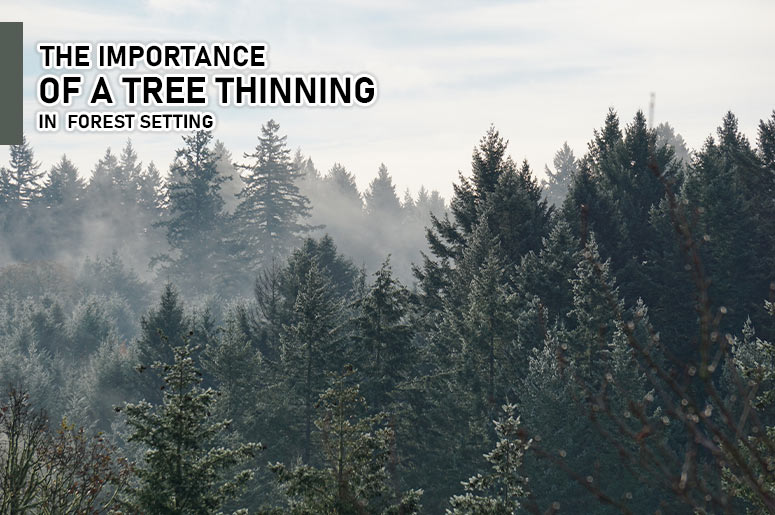The Importance Of Tree Thinning In A Forest Setting
What Is Tree Thinning?
Tree thinning is the removal of some trees, or parts of trees, to make room for new and healthier growth. In forestry, thinning is the selective removal of trees to improve the health and growth rate of other trees that are in the same area. Because overcrowded trees compete with each other for nutrients, water, and sunlight, there’s a big chance that they won’t get enough of their needs to grow healthy and strong.
How Is Tree Thinning Done?
Tree thinning operations are done by removing full rows of trees in a growing forest. Then, from the remaining rows, oddly-shaped, diseased, and damaged trees will also be removed. This enables the remaining healthy trees to grow to their full potential in the next six to eight years. The healthy trees will become more productive and ideal to be used as lumber, furniture, and other wood products.
Types of tree thinning:
- Thinning from below– removing trees that will not lead to high-quality tree crown growth
- Thinning from above– removing all of the trees that impact crowns on other trees.
- Diameter – removing large trees over a certain diameter so smaller trees in good condition to grow.
- Geometrical thinning– removing trees by row, regardless of their condition.
- Free thinning– removing undesired trees in different areas, without much planning.
Why Is Tree Thinning Important?
Landowners know the value of proper tree maintenance in forest stands. They recognise the many uses and importance of tree thinning in forestry. Among the most useful ways to ensure a healthy, safe, and productive forest, tree thinning ranks at the top. To know more about the importance of tree thinning, below is a list of benefits it can provide.
Improves The Environment
Tree thinning has a positive influence on an entire forest environment. By thinning a tree canopy, there is better penetration of light and rainwater, which increases the availability of moisture and nutrients within the soil. Additionally, it creates more productive forest vegetation that can support many animal species. Furthermore, it improves the quality of the air around it, contributing to a healthier and happier environment.
Prevents Disease And Infestations
Tree thinning is an important part of tree maintenance. Controlling a stand’s density helps keep the trees healthy and saves them from damage caused by disease and insects. Unmanaged and heavily stocked stands are more susceptible to certain diseases and insects because they grow weaker. Once a tree becomes infected, the disease also quickly spreads to adjacent trees. This is because the root systems of dense stands are intertwined, making it easy for a disease to reach other nearby trees.
Increases Growth
Periodic tree thinning maximises an area’s growth potential, which results in larger, healthier trees and more useable timber. It allows the healthiest tree species to continue growing while removing the undesirable, damaged, diseased, and low-vigour trees that will only hamper the healthy growth of the whole forest stand.
Enhances Tree Genetics
Proper and regular thinning promotes genetic enhancement. Some trees are diseased or have questionable shapes caused by their genetic composition. By getting rid of weak and undesirable trees before forest regeneration, there can be less of them growing in a stand. Instead, the strongest, most beautifully shaped trees will thrive and multiply.
Minimises Fire Risk
Tree thinning helps in managing the damage and risks brought by wildfires. This is particularly important in Australia, where forest fires are a constant threat. Thinned forests help stop huge fires before they can reach communities and homes. A huge fire that reaches a thinned stand, transitions from being an active crown fire into a passive crown fire. By then, it becomes less intense and unable to propagate from tree to tree. With the reduced intensity, it will also become easier for the flames to be completely extinguished.
Conclusion
Tree thinning is an important silvicultural practice to control the growth and quality of forests to meet production or timber needs. It increases the resistance of trees against drought, insect infestation, and extreme weather conditions. Additionally, it keeps a forest from being a potentially dangerous tinderbox of wildfire fuel by minimising fire risks. An uncontrolled forest could attract many catastrophic results. Keep the importance of tree thinning in mind to ensure a higher vigour and a more valuable tree stand.
To learn more about tree thinning and other tree care practices, get in touch with our professional arborists at Tall Timbers Tree Services. We will gladly assist you with your tree care needs at very affordable rates. Whether you are looking after trees in a huge piece of land, or a few trees in your yard, we are here to help. We can provide you with the correct methods of thinning forests, as well as thinning tree branches. Through our services, your trees will continue to grow healthy and strong while keeping you and your loved ones safe and comfortable.

